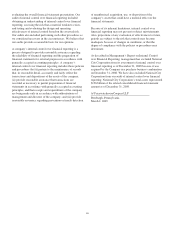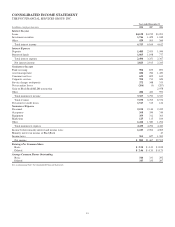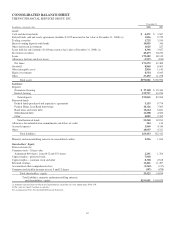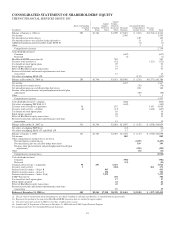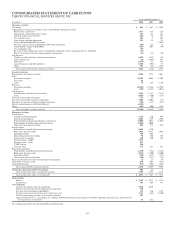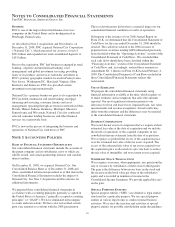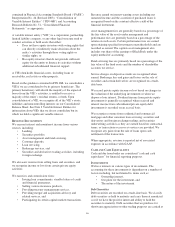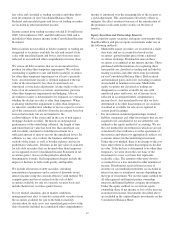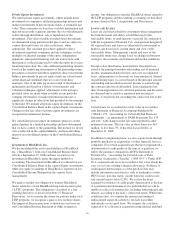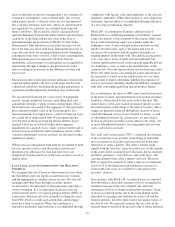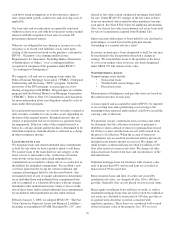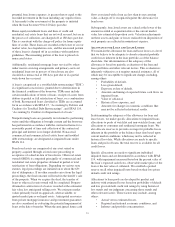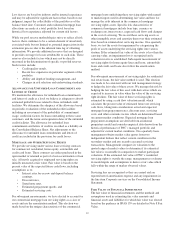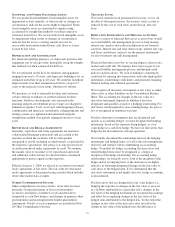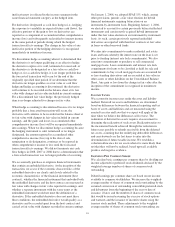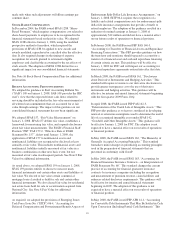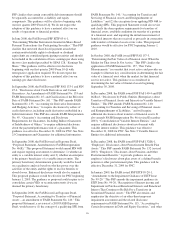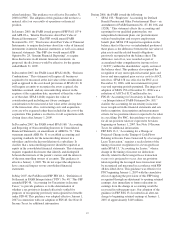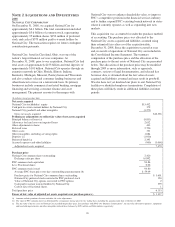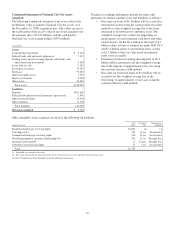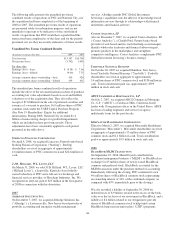PNC Bank 2008 Annual Report Download - page 94
Download and view the complete annual report
Please find page 94 of the 2008 PNC Bank annual report below. You can navigate through the pages in the report by either clicking on the pages listed below, or by using the keyword search tool below to find specific information within the annual report.cash flows using assumptions as to discount rates, interest
rates, prepayment speeds, credit losses and servicing costs, if
applicable.
Our loan sales and securitizations are generally structured
without recourse to us and with no restrictions on the retained
interests with the exception of loan sales to certain US
government chartered entities.
When we are obligated for loss-sharing or recourse in a sale,
our policy is to record such liabilities at fair value upon
closing of the transaction based on the guidance contained in
FIN 45, “Guarantor’s Accounting and Disclosure
Requirements for Guarantees, Including Indirect Guarantees
of Indebtedness of Others,” or as a contingent liability
recognized at inception of the guarantee under SFAS 5,
“Accounting for Contingencies.”
We originate, sell and service mortgage loans under the
Federal National Mortgage Association (“FNMA”) Delegated
Underwriting and Servicing (“DUS”) program. Under the
provisions of the DUS program, we participate in a loss-
sharing arrangement with FNMA. We participate in a similar
program with the Federal Home Loan Mortgage Corporation
(“FHLMC”). Refer to Note 25 Commitments and Guarantees
for more information about our obligations related to sales of
loans under these programs.
In securitization transactions, we classify securities retained as
debt securities available for sale or other assets, depending on
the form of the retained interest. Retained interests that are
subject to prepayment risk are reviewed on a quarterly basis
for impairment. If the fair value of the retained interests is
below its carrying amount and the decline is determined to be
other than temporary, then the decline is reflected as a charge
in other noninterest income.
L
OANS HELD FOR SALE
We designate loans and related unfunded loan commitments
as held for sale when we have a positive intent to sell them.
We transfer loans to the loans held for sale category at the
lower of cost or fair market value. At the time of transfer,
write-downs on the loans and related unfunded loan
commitments are recorded as charge-offs or as a reduction in
the liability for unfunded commitments. We establish a new
cost basis upon transfer except for certain residential and
commercial mortgages held for sale discussed below. Any
subsequent lower of cost or market adjustment is determined
on an individual loan and unfunded loan commitment basis
and is recognized as a valuation allowance with any charges
included in other noninterest income. Gains or losses on the
sale of these loans and/or related unfunded loan commitments
are included in other noninterest income when realized.
Effective January 1, 2008, we adopted SFAS 159, “The Fair
Value Option for Financial Assets and Financial Liabilities –
Including an amendment of FASB Statement No. 115”, and
elected to fair value certain commercial mortgage loans held
for sale. Under SFAS 159, changes in the fair value of these
loans are measured and recorded in other noninterest income
each period. See Note 8 Fair Value for additional information.
Also, we elected fair value for residential real estate loans held
for sale or securitization acquired from National City.
Interest income with respect to loans held for sale classified as
performing is accrued based on the principal amount
outstanding at a constant effective yield.
In certain circumstances, loans designated as held for sale may
be transferred to the loan portfolio based on a change in
strategy. We transfer these loans to the portfolio at the lower
of cost or fair market value; however, any loans designated
under SFAS 159 will remain at fair value.
N
ONPERFORMING
A
SSETS
Nonperforming assets include:
• Nonaccrual loans,
• Troubled debt restructurings, and
• Foreclosed assets.
Measurement of delinquency and past due status are based on
the contractual terms of each loan.
A loan acquired and accounted for under SOP 03-3 is reported
as an accruing loan and a performing asset as long as the
remaining future expected undiscounted cash flows exceed the
carrying value of the loan.
We generally classify commercial loans as nonaccrual when
we determine that the collection of interest or principal is
doubtful or when a default of interest or principal has existed
for 90 days or more and the loans are not well-secured or in
the process of collection. When the accrual of interest is
discontinued, any accrued but uncollected interest previously
included in net interest income is reversed. We charge off
small business commercial loans less than $1 million at 120
days after transfer to nonaccrual status. We charge off other
nonaccrual loans based on the facts and circumstances of the
individual loans.
Subprime mortgage loans for first liens with a loan to value
ratio of greater than 90% and second liens are classified as
nonaccrual at 90 days past due.
Most consumer loans and lines of credit, not secured by
residential real estate, are charged off after 120 to 180 days
past due. Generally, they are not placed on non-accrual status.
Home equity installment loans and lines of credit, as well as
residential mortgage loans, that are well secured by residential
real estate are classified as nonaccrual at 180 days past due or
if a partial write-down has occurred, consistent with
regulatory guidance. These loans are considered well secured
if the fair market value of the property, less 15% to cover
90


